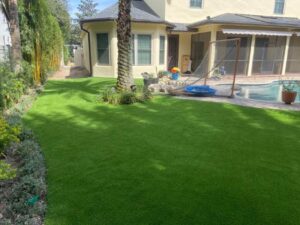
Synthetic turf, often referred to as artificial grass or artificial turf, has gained popularity as a low-maintenance alternative to natural grass in various settings, from residential lawns to sports fields and public spaces. While synthetic turf offers numerous benefits, including water conservation and reduced maintenance costs, it also raises concerns about its ecological impact. In this article, we’ll delve into the ecological effects of synthetic turf to understand its implications on the environment.
Water Conservation
One of the primary ecological benefits of synthetic turf is its potential for water conservation. Unlike natural grass, which requires regular watering to maintain its lush appearance, synthetic turf does not need irrigation once installed. This can lead to significant reductions in water usage, particularly in regions facing water scarcity or drought conditions. By minimizing the demand for freshwater resources, synthetic turf helps conserve water and promotes sustainable water management practices.
Reduction of Chemical Inputs
Maintaining natural grass lawns often involves the use of fertilizers, pesticides, and herbicides to promote growth and control pests. These chemicals can leach into the soil and waterways, posing risks to ecosystems and human health. Synthetic turf eliminates the need for chemical inputs, thereby reducing the potential for water pollution and soil contamination. By creating a chemical-free environment, synthetic turf supports biodiversity and promotes ecological balance in urban and suburban landscapes.
Mitigation of Urban Heat Island Effect
Urban heat islands, characterized by higher temperatures in urban areas compared to surrounding rural areas, can have detrimental effects on local ecosystems and human well-being. Artificial grass has the potential to mitigate the urban heat island effect by reducing surface temperatures in urban environments. Unlike natural grass, which absorbs solar radiation and retains heat, synthetic turf reflects sunlight and maintains lower surface temperatures. This can help create cooler and more comfortable outdoor spaces, reducing the energy demand for cooling and mitigating heat-related health risks.
Challenges and Considerations
While synthetic turf offers ecological benefits, it is not without its challenges and considerations. Critics argue that synthetic turf may contribute to environmental problems such as heat retention, habitat loss, and microplastic pollution. Additionally, the production, installation, and disposal of synthetic turf involve energy consumption and emissions, raising questions about its overall environmental footprint. To address these concerns, advancements in technology and sustainable practices are needed to minimize the ecological impacts of synthetic turf throughout its lifecycle.
Synthetic turf presents both opportunities and challenges in terms of its ecological effects. While it offers benefits such as water conservation, reduced chemical inputs, and mitigation of the urban heat island effect, it also raises concerns about its environmental footprint and potential ecological consequences. As we continue to explore alternative landscaping solutions, it’s essential to consider the ecological effects of synthetic turf and strive for sustainable practices that minimize harm to the environment. By adopting environmentally conscious approaches to synthetic turf installation and maintenance, we can harness its potential while safeguarding ecosystems for future generations.
The Outdoor Living Pros is committed to promoting sustainable landscaping practices and offering environmentally friendly solutions for your outdoor spaces. Contact us today to learn more about our eco-conscious products and services.
(888) 297-6972

Recent Comments